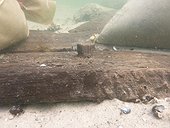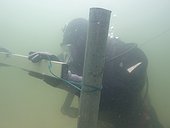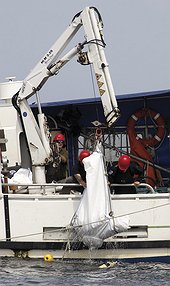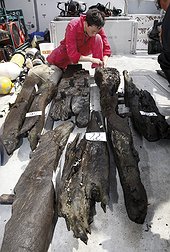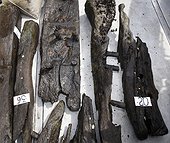First Shipwreck Parts Salvaged from Bay of Greifswald
July 15, 2009 | Zug/Rügen | Today, on 15 July, 2009, the employees of the Mecklenburg-Western Pomerania Office for Culture and Care of Monuments (LaKD M-V) started to salvage the remnants of a wreck in the Bay of Greifswald, Germany.
“The salvage is needed in order to create the necessary room for construction – a 60-metre-wide corridor – for the laying of the Nord Stream Pipeline, which is planned for the coming spring,” said Nord Stream Permitting Manager Jens Lange. “After intensive examination of different alternatives, the LaKD M-V, in close coordination with us, decided on exactly this approach.”
At the beginning of June, up to 7 research divers started the extensive preparatory work for the salvage. Bad weather, occasionally very strong currents and unfavourable underwater visibility put more of a strain on the schedule than planned. In the past few weeks, the find spot was cleared of stones and sediment and the wreck remnants were completely uncovered. Immediately after the clearing, each individual part was secured with sandbags against the strong current and waves. Subsequently, a survey system was installed underwater and the find spot was documented using drawings, as well as photo and video recording.
The work of recent weeks confirmed past assumptions. The remnants of the wreck are located in a find spot 9 metres long and 3 metres wide. They are aligned in an east-west direction. In 1715, the Swedish navy loaded the ship with ballast stones and sank it at the mouth of the bay. In the last 300 years, wind and waves took their toll. Large parts of the ship were washed away by the current, and the remaining wood is quite eroded in places. More than 50 individual parts were identified and are to be salvaged at the find spot. These are mostly frames and planks from the side of the hull, which are from 1.2 to 5 meters long, depending upon their type and condition. The parts are to be dismantled underwater and salvaged individually with the aid of the diver ship’s deck crane.
Even in optimum weather conditions, the salvage of the wreck parts will still take several working days. After the salvage, the individual parts will be brought ashore, secured, stored temporarily in the water nearby and duly documented and evaluated by LaKD M-V employees in a tent. Based on the results of this work, the LaKD M-V will then decide how to subsequently proceed with the wreck remnants.
Historical background of the shipwreck barrier
There are remnants of 20 historical shipwrecks south of the Mönchgut peninsula in the Bay of Greifswald. In 1715, the Swedish navy ballasted those ships, each about 15 metres long, positioning them to sink in water only 3 to 4 metres deep. Together, the ships formed a 980-metre defensive barrier which prevented enemy fleets from entering the bay. The remains of the wrecks were re-discovered in 1996 and were surveyed and charted in 2006 using a special scanner. The wreck planned for the salvage, at 9 metres long and 3 metres wide, is one of the smaller artefacts of the ship barrier. This concerns the remains of one of the ships in a staggered structure, a vessel built with overlapping planks.





